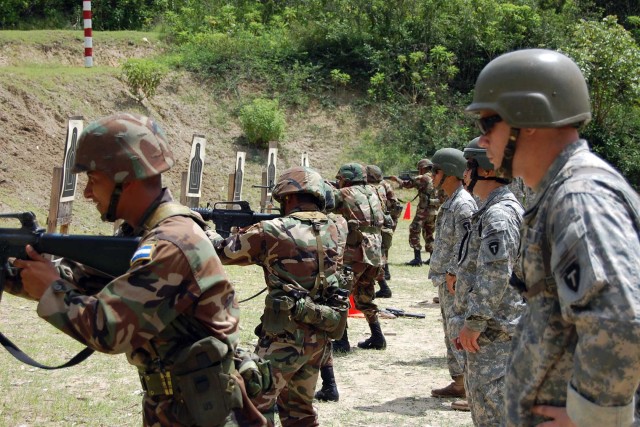SOTO CANO AIR BASE, Honduras (National Guard Bureau, Sept. 24, 2007) - Soldiers from the Texas Army National Guard's 36th Infantry Division trained with an elite group of Honduran military professionals Sept. 11-13.
Members of the 143rd Infantry Detachment (Long Range Surveillance) supported the training and mentoring program of U.S. Army South by joining their Honduran counterparts for weapons familiarization and urban tactics.
"When people think of USARSO, they think of humanitarian missions because that's what everybody sees," said Maj. Clarence Henderson, plans officer. "That's great, but also these coalition training missions is where the high payoff is found. It's simple Army talk. Soldiers share their common goals and problems and find out that they aren't that different from one another."
Airborne Ranger Capt. Matt Perritte, commander of the 143rd Infantry Detachment, said his infantrymen have valuable insight to share based on their combat experience. Eighty percent of his detachment's members have been to Iraq.
The Honduran forces consisted of a team of 30 pulled from a 130-man detachment of Army, Navy and Air Force professionals who currently form a rapid-response team known as the Peacekeeping Operations Battalion.
Many of those in attendance were preparing for their U.N. peacekeeping mission to Haiti by learning additional urban operations tactics.
Honduran Army Col. Raul Gutierrez, the liaison officer between his army and Soto Cano-based Joint Task Force Bravo, explained besides responding to natural disasters in the Central American region, the unit also provides local security for U.S. forces during USARSO's medical readiness training exercises and New Horizons humanitarian missions.
He said working together helps build upon relationships necessary to provide support for USARSO's "Beyond the Horizons" mission during 2008.
Staff Sgt. Andres Flores, who is sniper qualified, had many helpful hints for the Honduran infantrymen as they reinforced their firing skills. After stationary single-shots, they began firing multiple shots while turning and moving forward.
"In the real world we shoot more than just one bullet," Staff Sgt. Flores said candidly. "We'll progress to target discrimination drills in which we use black, orange and red targets. I will quickly call out a color for them to engage when they turn around." Staff Sgt. Flores said everyone would spend one day with M-16 rifles and another with M-9 pistols.
Honduran Army 2nd Lt. Javier Perez, a jumpmaster and a graduate of the U.S. Army's Ranger School at Fort Benning, Ga., said he rarely gets the opportunity to shoot lots of ammunition. He said he had shot more during the first day with the U.S. Army-supplied ammunition than during several previous qualification outings combined.
Besides perfecting their marksmanship, the Honduran forces learned the finer points of entering and clearing buildings while in stack or file formations. They also practiced safe techniques for going around corners.
"We're expanding beyond the army field manuals to include our practical field experiences," explained Sgt. 1st Class Jesse L. Kennis II. "We're always learning how to handle weapons for more realistic scenarios."
While Sgt. 1st Class Kennis acknowledged rifle skills were the primary focus for the training, he admitted to what most airborne qualified Soldiers really enjoy-jumping.
"We'll jump together from a Chinook, then do a wing exchange," Sgt. 1st Class Kennis said. "We are authorized to wear foreign jump wings on our Class A uniforms. A lot of our younger Soldiers don't have foreign wings, so they are looking forward to it."
2nd Lt. Perez echoed the exact same thoughts on behalf of his troops. "None of our airborne soldiers here have jumped with Americans before," he said. "They want to wear the U.S. jump wings."
Soldiers from both nations said the training was valuable. Small-unit familiarization like this pairs U.S. Soldiers with other nations from Central and South America as well.


Social Sharing